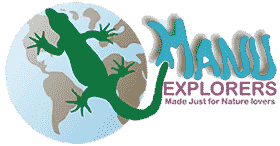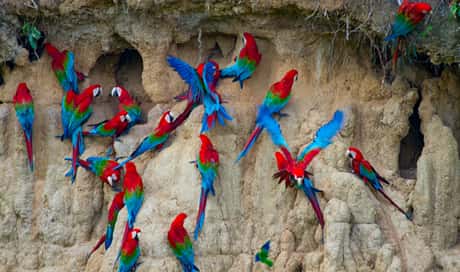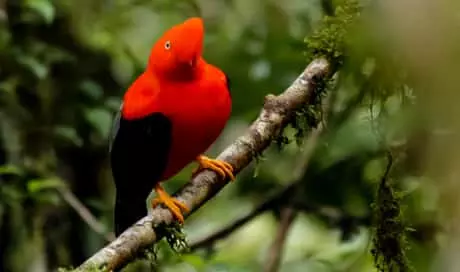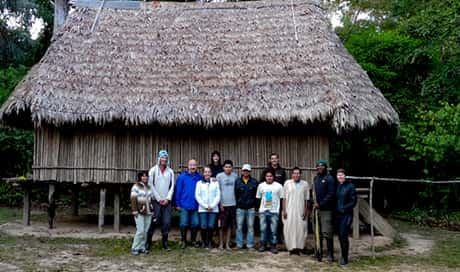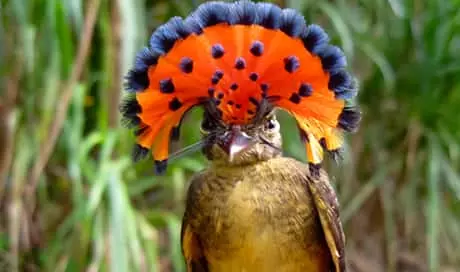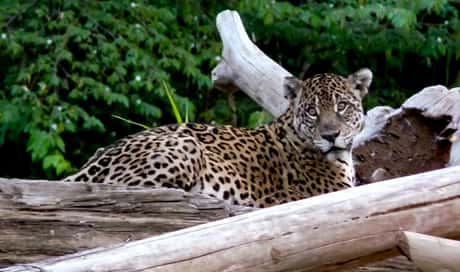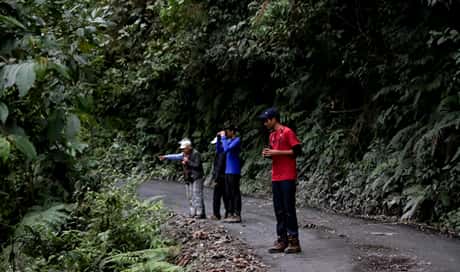All You need to know
information about Manu National Park
The Manu Biosphere Reserve is located southwest of Peru, partially located in the regions of Madre de Dios and Cusco, in the provinces of Manu and Paucartambo. With a territory of 1,909,800 has is divided into three zones: The National Park, with 1,532,806 ha; Reserved Zone, with 257,000 ha; and Cultural Transition Zone or, with 120,000 ha.
It ranges from 300m at the confluence of the Manu River with the Alto Madre de Dios River, to 3,800 meters at the summit of the mountain Apu Kañahuay. Some researchers believe that in the virgin areas of this reserve is found the Païtiti or the lost city of the Incas.
History of Manu National Park
Inca - colonial. Manu area has a history marked by the arrival of foreign people, since the times of the Incan Empire and since the Inca Pachacutec and Tupac Inca Yupanqui annexed this area to their empire, until the arrival of the Spaniards soon after the invasion of Cusco they founded Paucartambo, where they established farms and parcels and where also the king Carlos III of Spain ordered the construction of a bridge to facilitate trade of local products; and this how this valley began to supply products Cusco as coca, sugar, cotton, pepper, wood and others.
In March 1567, the Spanish Juan Alvarez Maldonado who was charge of the province of Mojos started a journey of 37 days to make the first expedition from Paucartambo to the current location of Pilcopata. In May of the same year, Manuel Escobar mounted a second expedition that followed the course of the Alto Madre de Dios River to the Manu River.
Republic era of Manu National Park
In 1861, Colonel Faustino Maldonado embarked on a new expedition from Paucartambo to the Madre de Dios River. It was after him that 30 years later, the rubber man, Carlos Fitzcarrald baptize the mouth of the Tambopata River to Puerto Maldonado, the actual capital of the department of Madre de Dios.
In the lowland forest, indigenous people were affected by extractive activities in the late nineteenth century, the rubber boom ushered in companies like bold Fitzcarrald, one of the most famous of that time. However, Manu area was partially exploited. Rubber activities ceased in the 20s when the resource, unable to recover to intensive exploitation and competition from the prosperous and less expensive crops in Asia started to decline.
Between 50 and 60, the construction of the final section of the road began the logging of cedar and mahogany and the work in the “haciendas” and then extraction of fine skins (jaguar, ocelot, and Giant otters). More recent are the oil exploration activities. Meanwhile, in the Andean region, agricultural activities were affected by the agrarian reform initiated in 1969.
Since the twentieth century, the religious presence became more significant. In 1902 the Dominicans founded their first mission in Asuncion. In 1908 they installed the second missionary position, San Luis del Manu, at the mouth of the Manu River; after leaving it, they settled in Pantiacolla mission, which after being washed away in a river flood the finally stablish in Shintuya in 1958.
In the Biosphere Reserve of Manu Park there is evidence of ancient cultures, such as petroglyphs Pusharo, a set of prints of those who still could not explain its origin and meaning, which were first reported by Father Vicente de Cenitagoya in 1921 and are located on the right blank the Shinquivenia tributary of Palotoa river; other petroglyphs are found in the Queros river on a great rock wall "Xinkiori" which is legendary for Huachipaeris. Similarly, we are aware of an archaeological site in the area Mameria located in the headwaters of the Piñi Piñi River.
Creation of Manu National Park
In 1967, at the initiative of Celestino Kalinowski, son of a famous Polish naturalist who came to Peru in 1887, and the report of the British advisor Ian Grimwood, the Peruvian state was recommended the creation of a National Park in Manu. In 1968 it was declared a National Forest and subsequently the Manu National Park was established on May 29, 1973, by Supreme Decree 0644-73-AG, in order to preserve its natural and cultural heritage for the benefit of present and future; determined for the same purpose by UNESCO recognition of the Biosphere Reserve of Manu which today covers an area of 1,881,200 ha (18,812 square kilometers) in the provinces of Paucartambo in Cusco and Manu in Madre de Dios. Its boundaries were drawn by applying the principle of natural boundaries and river tributaries. However, the boundary of the park in the same river Manu had to stop at the confluence with the river Panahua because there was an oil exploration.
Distribution of Manu National Park
The Nucleo Zone: The Nucleo Zone or Manu National Park area is dedicated to the protection and only anthropological and biological research are allowed, limited to the observation of life and ecological processes in their natural form; in the Park is found the Cocha Cashu Biological Station, one of the most important research centers in tropical forests. The place is intangible and to visit it you should have a special permission.
In this same area there are human populations of native Amazonian belonging to different ethnic groups that inhabit from time immemorial, whose number is estimated at about 1000 indigenous; however, there is also a Quechua population of approximately 200 people in the area Callanga.
The Reserved Zone: Manu Reserved Zone is located in the lower part of the Manu River, in this area tourist activities (organized by authorized agencies) and research with minimal manipulation are allowed. You may observe a rich natural landscape by the large number of flora and wildlife visible from the rivers and the "lakes" (meandering river that close and are isolated from the mainstream, forming ponds that hold a wealth of fauna). The visits are controlled. It extends from the Panagua River to Boca Manu.
The Cultural Zone: The cultural area is formed by the basin of Alto Madre de Dios River and the Andean territories bordering the southern part of the reserve, the dividing line between the National Park and the Mapacho River. This area is dominated by settler populations who develop agricultural, livestock and forestry activities and who have basic health, education and development, although incipiently. Conducting environmental activities is permitted.
Around the Manu Biosphere Reserve there are other areas such as State territorial lands in favor of Ethnic Groups Kugapakori and Nahua, the Megantoni Sanctuary and the Amarakaeri Reserved Zone; because the expansion of these territories plus the basin of Mapacho river expanded of the existing cultural area later called (Multiple Andean and Amazon use area) are considered within studies and proposals for integrating them into the Biosphere Reserve of Manu.
Manu National Park distribution areas Map:

Geography of Manu National Park
The Grass land: In its vast territory, from the high plateaus of 3500 m, covered with grass, where the dry air and temperatures vary as is the sun or under the shade, and depending on the month reaching -9 ° C to 22 ° C between the months of September and April and times of snow or hail rains between October and April; is down a long stretch of transition called "wooded thicket or matorral boscoso " that descends to about 2,600 meters from where the vegetation forms a forest, which to date have identified about 450 species of plants and area where rainfall can reach between 500 and 1000 mm.
The Forests “Montana Baja": takes place between 2200 and 1650 m; there are found trees up to 25 m in height covered with orchids and ferns growing families on the walls of the deep precipices. These can be found Araceaes broad leaves and tree ferns that characterize the place, covered in these cloud forests there is a cold climate and landscape between shadows and penumbras which is constantly wet.
The "Rainy Montaña" forest: This area is also known as "cloud forest" and is an almost magical place located between 600 and 1650 meters, the fog is constant and covers the beautiful landscape full of greenery, trees here are up to 30 m height which are overgrown by orchids, and ferns forming a dense forest interrupted only by small streams and waterfalls that are born and are lost in the vegetation. At present it is estimated that this area contains no less than 200 different species of trees with a density that can exceed 700 per hectare. Here the temperature varies between 20 ° and 25 ° C at night can drop to 16 or 18 ° C.
The "tropical humid forest": This area is also called "lowland" and spreads over the vast Amazonian plain from 300 to 600 meters. This is undoubtedly the most representative area of the Reserve. Here at Manu area meandering river, the trees have a gigantic height; on the high tops of these, only two species emerge beyond the wall or ceiling canopy of the forest: the robust shihuahuaco (Dipteryx micrantha) and kapok (Ceiba pentandra) which are the highest of the forest trees and can exceed 60 m tall and has a crown up to 50 m in diameter.
Climate of Manu National Park.
The rainy season or low season is from January to March, but year round can be unexpected rains; temperatures in the low areas are between 35ºC day and 25ºC overnight.
Culture and People of Manu National Park
Just as this place has a great variety of wildlife flora and fauna is also home to a significant sample of cultural diversity represented by different peoples that possess a major culture and folklore, each with its own language, ways of gathering, hunting, fishing, religious rituals as well as medicine.
These people have different degrees of contact with the majority culture of Peru. Although often see these people in western clothes, it is not difficult to perceive that their world view and language are unique.
In the territory of the Manu National Park there are 30 rural communities that maintain the Quechua language as their official language, there are also several Amazonian native peoples who inhabit this land since immemorial times, such as the Matsiguenka, Amahuaca, Yine, Amarakaeri, Huashipaire and Nahua; plus other without any contact with the modern world.
Flora and Fauna of Manu National Park
Its ecological wealth is important. The zone contains over 15,000 plant species. In the Manu is possible to find the full range of ecological zones that exist in the Amazon and this makes it one of the most appreciated. In a single hectare have come to find up to 250 varieties of trees.
The Manu Park biodiversity contains more than 20,000 types of plants, 1,000 species of birds, 1,200 of butterflies and 200 mammals including the jaguar, the giant otter and 13 species of monkeys like the Pygmy marmoset (Cebuella pygmaea) which is the smallest monkey in the world with 100 grams of weight and the Black Spider monkey with 9 kilos.
- Mammals: 159 species
- Reptiles: 99 species
- Amphibians: 140 species
- Birds: over 1000 species
- Fish: 210 species
- Insects which do not were scientifically classified
- butterflies: 1307 species
- Ants: 300 species
- Anisopteras/dragon flies: 136 species
- Bees: 650 species
The Manu National Park is the largest protected Park with the most biodiversity in the world.
